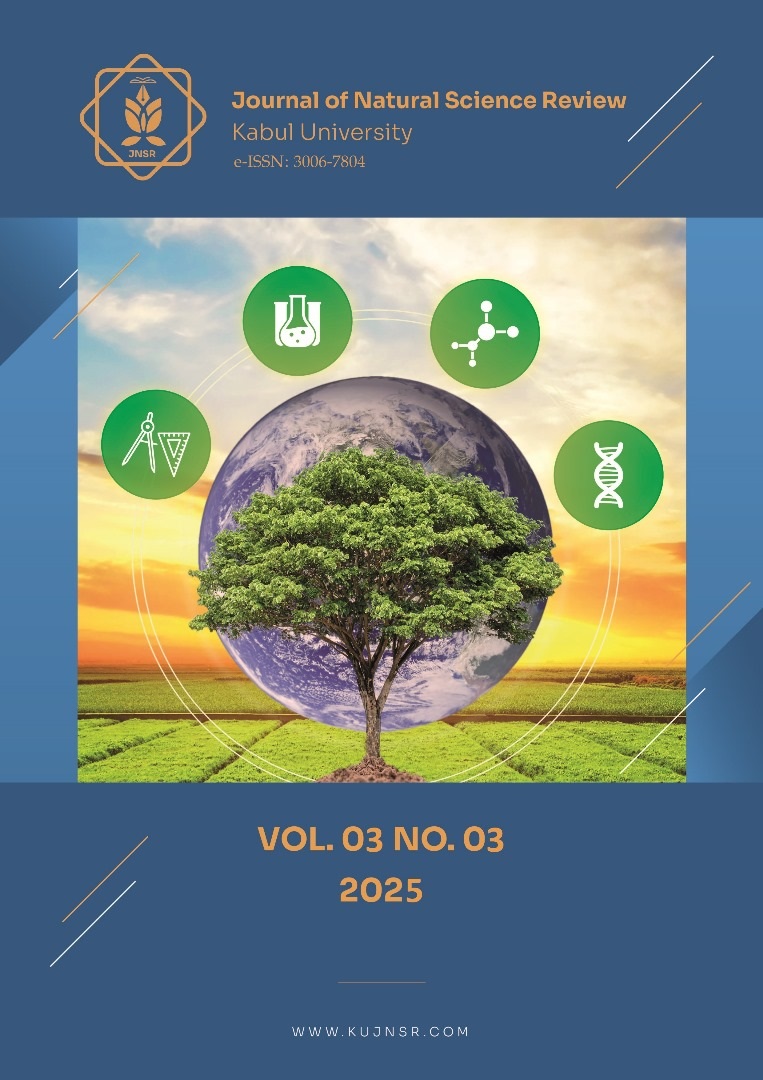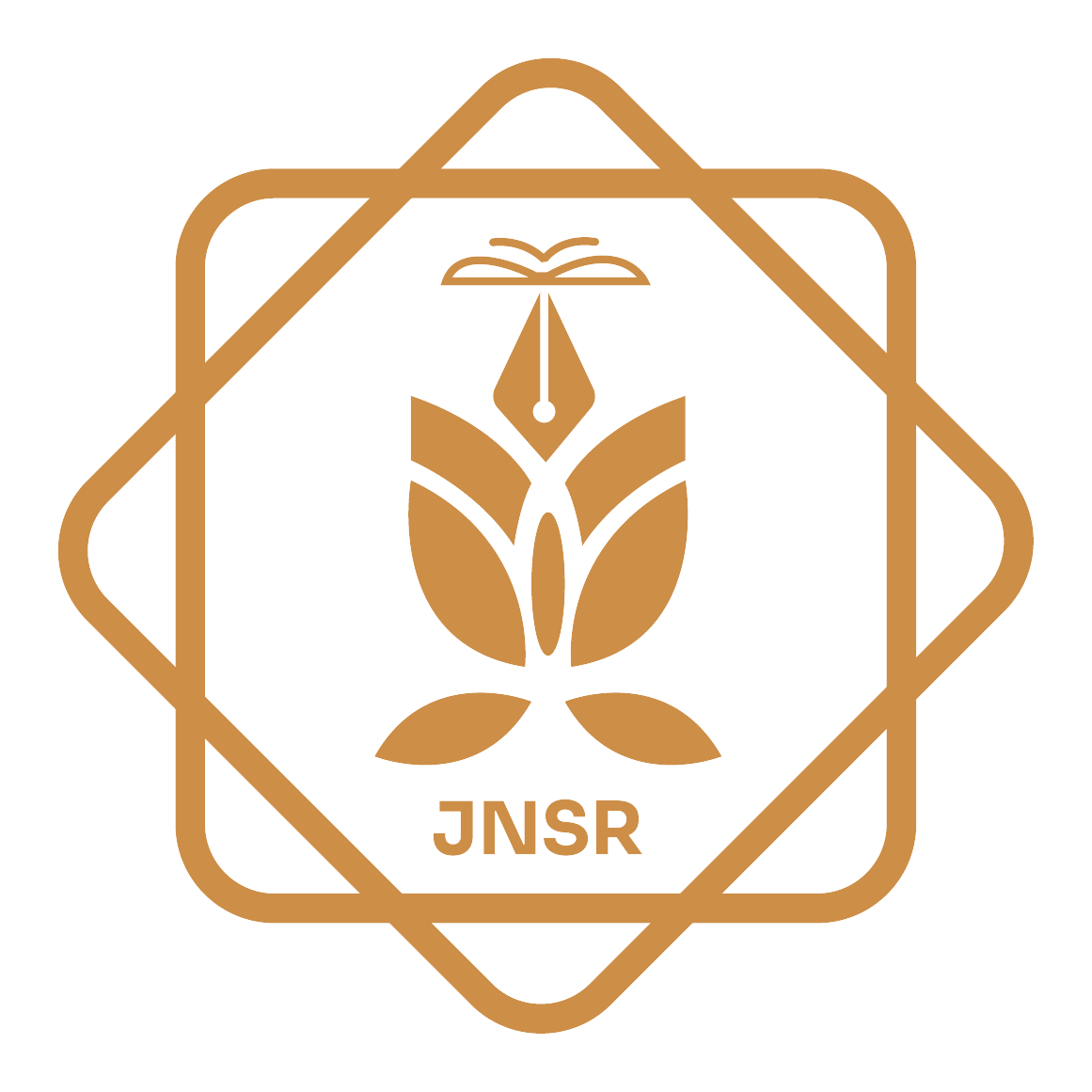Thiosemicarbazone Ligands and TheirTransition Metal Complexes as Antioxidants: A Review
DOI:
https://doi.org/10.62810/jnsr.v3i3.252Keywords:
Antioxidant Activity, ABTS method, Capacity, CUPRAC method, DPPH method, Metal complexes, Thiosemicarbazone ligandsAbstract
Antioxidant molecules prevent the harmful reaction of oxidants inside the body by providing a single electron or hydrogen atom based on their mechanism. Different forms of oxidants such as reactive oxygen species (ROS) or reactive nitrogen species (RNS) could harm the proteins, lipids, and DNA. Due to the chain reactions of oxidants in the medium that exist, unwanted consequences could happen inside the body. The antioxidants by reacting with oxidants prevent the damages caused by the chain reaction of oxidants. Natural antioxidants are a well-known group of matters such as vitamins, fruits, vegetables, and nuts. The antioxidant capacity/activity of natural antioxidants is studied comprehensively and reported in the literature. Synthetic antioxidants such as thiosemicarbazones either in the form of ligand or their metal complexes, could exhibit potent antioxidant capacity/activity comparable or sometimes more potent compared to the natural antioxidant. The existence of different electron donor groups in the structure of thiosemicarbazones such as hydroxyl and amine groups, could appear in the form of antioxidant capacity or activity. In the literature, various methods of determining the antioxidant capacity/activity of compounds such as thiosemicarbazones are reported. Among them, the three methods such as CUPRAC (CUPric Reducing Antioxidant Capacity), DPPH (2,2-di(4-tert-octyl phenyl)-1-picrylhydrazyl) and ABTS (2,2’-azino-bis (3-ethylbenzthiazoline-6-acid) are well-known methods for the evaluating of antioxidant capacity/activity of thiosemicarbazones. In this review, the antioxidant capacity/activity of thiosemicarbazones by the last three methods is studied and the relationship between the structure of thiosemicarbazone ligands and their corresponding metal complexes with their antioxidant capacity/activity is analyzed.
Downloads
References
Ali, S. S., Ahsan, H., Zia, M. K., Siddiqui, T., & Khan, F. H. (2020). Understanding oxidants and antioxidants: Classical team with new players. Journal of Food Biochemistry, 44(3). https://doi.org/10.1111/jfbc.13145 DOI: https://doi.org/10.1111/jfbc.13145
Ain, Q. U., Singh, A., Singh, I., Carmieli, R., & Sharma, R. (2023). Synthesis, characterization and anti-tubercular activities of copper(II) complexes of substituted 2,3-isatin bisthiosemicarbazones: An experimental and theoretical approach. Results in Chemistry, 6, 101171. https://doi.org/10.1016/j.rechem.2023.101171 DOI: https://doi.org/10.1016/j.rechem.2023.101171
Apak, R., Güçlü, K., Özyürek, M., & Karademir, S. E. (2004). Novel Total Antioxidant Capacity Index for dietary polyphenols and vitamins C and E, using their Cupric ion reducing capability in the presence of neocuproine: CUPRAC method. Journal of Agricultural and Food Chemistry, 52(26), 7970–7981. https://doi.org/10.1021/jf048741x DOI: https://doi.org/10.1021/jf048741x
Altiparmak, E. A., Yazar, S., Özdemir, N., Bal-Demirci, T., & Ülküseven, B. (2021). Supramolecular Ni(II) complex aggregates with a circular linkage of intermolecular multi-hydrogen bonding frameworks based on thiosemicarbazone, and a Cu(II) complex: Synthesis, structural, DFT, electrochemical and antioxidant studies. Polyhedron, 209, 115457. https://doi.org/10.1016/j.poly.2021.115457 DOI: https://doi.org/10.1016/j.poly.2021.115457
Aneesrahman, K., Ramaiah, K., Rohini, G., Stefy, G., Bhuvanesh, N., & Sreekanth, A. (2019). Synthesis and characterisations of copper(II) complexes of 5-methoxyisatin thiosemicarbazones: Effect of N-terminal substitution on DNA/protein binding and biological activities. Inorganica Chimica Acta, 492, 131–141. https://doi.org/10.1016/j.ica.2019.04.019 DOI: https://doi.org/10.1016/j.ica.2019.04.019
Bal-Demirci, T., Güveli, Ş., Yeşilyurt, S., Özdemir, N., & Ülküseven, B. (2019). Thiosemicarbazone ligand, nickel(II) and ruthenium(II) complexes based on vitamin B6 vitamer: The synthesis, different coordination behaviors and antioxidant activities. Inorganica Chimica Acta, 502, 119335. https://doi.org/10.1016/j.ica.2019.119335 DOI: https://doi.org/10.1016/j.ica.2019.119335
Brand-Williams, W., Cuvelier, M., & Berset, C. (1995). Use of a free radical method to evaluate antioxidant activity. LWT, 28(1), 25–30. https://doi.org/10.1016/s0023-6438(95)80008-5 DOI: https://doi.org/10.1016/S0023-6438(95)80008-5
Basyouni, W. M., Abbas, S. Y., El-Bayouki, K. a. M., Daawod, R. M., & Elawady, M. K. (2021). Synthesis and antiviral evaluation of 5-(arylazo)salicylaldehyde thiosemicarbazone derivatives as potent anti-bovine viral diarrhea virus agents. Synthetic Communications, 51(El-Helw et al., 2019), 2168–2174. https://doi.org/10.1080/00397911.2021.1925298 DOI: https://doi.org/10.1080/00397911.2021.1925298
Cárdenas, A., Gomez, M., & Frontana, C. (2014). Electrochemical method to quantify antioxidants employing Cupric reducing antioxidant capacity, CUPRAC. Procedia Chemistry, 12, 62–65. https://doi.org/10.1016/j.proche.2014.12.042 DOI: https://doi.org/10.1016/j.proche.2014.12.042
Erel, O. (2004). A novel automated direct measurement method for total antioxidant capacity using a new generation, more stable ABTS radical cation. Clinical Biochemistry, 37(4), 277–285. https://doi.org/10.1016/j.clinbiochem.2003.11.015 DOI: https://doi.org/10.1016/j.clinbiochem.2003.11.015
Eğlence-Bakır, S., Şahin, M., Özyürek, M., & Ülküseven, B. (2021). Dioxomolybdenum(VI) complexes with 4-benzyloxysalicylidene-N/S-alkyl thiosemicarbazones: Synthesis, structural analysis, antioxidant activity and xanthine oxidase inhibition. Polyhedron, 209, 115467. https://doi.org/10.1016/j.poly.2021.115467 DOI: https://doi.org/10.1016/j.poly.2021.115467
Eğlence-Bakır, S., Sacan, O., Şahin, M., Yanardag, R., & Ülküseven, B. (2019). Dioxomolybdenum(VI) complexes with 3-methoxy salicylidene-N-alkyl substituted thiosemicarbazones. Synthesis, characterization, enzyme inhibition and antioxidant activity. Journal of Molecular Structure, 1194, 35–41. https://doi.org/10.1016/j.molstruc.2019.05.077 DOI: https://doi.org/10.1016/j.molstruc.2019.05.077
El-Helw, E. a. E., Sallam, H. A., & Elgubbi, A. S. (2019). Antioxidant activity of some N-heterocycles derived from 2-(1-(2-oxo-2H-chromen-3-yl)ethylidene) hydrazinecarbothioamide. Synthetic Communications, 49(20), 2651–2661. https://doi.org/10.1080/00397911.2019.1638938 DOI: https://doi.org/10.1080/00397911.2019.1638938
Floch, C., Alarcon-Gutiérrez, E., & Criquet, S. (2007). ABTS assay of phenol oxidase activity in soil. Journal of Microbiological Methods, 71(3), 319–324. https://doi.org/10.1016/j.mimet.2007.09.020 DOI: https://doi.org/10.1016/j.mimet.2007.09.020
Fuior, A., Cebotari, D., Garbuz, O., Calancea, S., Gulea, A., & Floquet, S. (2022). Biological properties of a new class of [Mo2O2S2]-based thiosemicarbazone coordination complexes. Inorganica Chimica Acta, 548, 121372. https://doi.org/10.1016/j.ica.2022.121372 DOI: https://doi.org/10.1016/j.ica.2022.121372
Findik, M., Türkkan, E., Pehlivanoglu, S., Sayin, U., Ceylan, U., & Akgemci, E. G. (2023). New copper(II) complex based-thiosemicarbazone and phenanthroline: DNA/BSA binding, antiproliferative activity, DFT and docking studies. Inorganic Chemistry Communications, 156, 111300. https://doi.org/10.1016/j.inoche.2023.111300 DOI: https://doi.org/10.1016/j.inoche.2023.111300
Gulcin, İ. (2020). Antioxidants and antioxidant methods: an updated overview. Archives of Toxicology, 94(3), 651–715. https://doi.org/10.1007/s00204-020-02689-3 DOI: https://doi.org/10.1007/s00204-020-02689-3
Graur, I., Bespalova, T., Graur, V., Tsapkov, V., Garbuz, O., Melnic, E., Bourosh, P., & Gulea, A. (2023). A new thiosemicarbazone and its 3d metal complexes: Synthetic, structural, and antioxidant studies. Journal of Chemical Research, 47(6). https://doi.org/10.1177/17475198231216422
Ghafoor, A., Hassan, H. R., Ismail, M., Malik, W. M. A., Afaq, S., Nawaz, H., Manzoor, S., Nisa, M. U., Verpoort, F., & Chughtai, A. H. (2024). Synthesis, characterization and molecular docking studies of bioactive 1,3-Thiazoles as promising antibacterial and antioxidant agents. Results in Chemistry, 7, 101328. https://doi.org/10.1016/j.rechem.2024.101328 DOI: https://doi.org/10.1016/j.rechem.2024.101328
Graur, I., Bespalova, T., Graur, V., Tsapkov, V., Garbuz, O., Melnic, E., Bourosh, P., & Gulea, A. (2023). A new thiosemicarbazone and its 3d metal complexes: Synthetic, structural, and antioxidant studies. Journal of Chemical Research, 47(6). https://doi.org/10.1177/17475198231216422 DOI: https://doi.org/10.1177/17475198231216422
Graur, I., Graur, V., Cadin, M., Garbuz, O., Bourosh, P., Melnic, E., Lozan-Tirsu, C., Balan, G., Tsapkov, V., Fala, V., & Gulea, A. (2024). Synthesis and Characterization of Copper(II) and Nickel(II) Complexes with 3-(Morpholin-4-yl)propane-2,3-dione 4-Allylthiosemicarbazone Exploring the Antibacterial, Antifungal and Antiradical Properties. Molecules, 29(16), 3903. https://doi.org/10.3390/molecules29163903 DOI: https://doi.org/10.3390/molecules29163903
Graur, V., Mardari, A., Bourosh, P., Kravtsov, V., Usataia, I., Ulchina, I., Garbuz, O., & Gulea, A. (2023). Novel Antioxidants Based on Selected 3d Metal Coordination Compounds with 2-Hydroxybenzaldehyde 4,S-Diallylisothiosemicarbazone. Acta Chimica Slovenica, 70(1), 122–130. https://doi.org/10.17344/acsi.2022.7885 DOI: https://doi.org/10.17344/acsi.2022.7885
Hernández, W., Carrasco, F., Vaisberg, A., Spodine, E., Icker, M., Krautscheid, H., Beyer, L., Tamariz-Angeles, C., & Olivera-Gonzales, P. (2023). Novel Thiosemicarbazone Derivatives from Furan-2-Carbaldehyde: Synthesis, Characterization, Crystal Structures, and Antibacterial, Antifungal, Antioxidant, and Antitumor Activities. Journal of Chemistry, 2023, 1–20. https://doi.org/10.1155/2023/5413236 DOI: https://doi.org/10.1155/2023/5413236
İlhan-Ceylan, B. (2020). Oxovanadium(IV) and Nickel(II) complexes obtained from 2,2′-dihydroxybenzophenone-S-methyl-thiosemicarbazone: Synthesis, characterization, electrochemistry, and antioxidant capability. Inorganica Chimica Acta, 517, 120186. https://doi.org/10.1016/j.ica.2020.120186 DOI: https://doi.org/10.1016/j.ica.2020.120186
Khalaji, A. D., Shahsavani, E., Feizi, N., Kucerakova, M., Dusek, M., & Mazandarani, R. (2016). Silver(I) thiosemicarbazone complex [Ag(catsc)(PPh3)2]NO3: Synthesis, characterization, crystal structure, and antibacterial study. Comptes Rendus Chimie, 20(5), 534–539. https://doi.org/10.1016/j.crci.2016.09.001 DOI: https://doi.org/10.1016/j.crci.2016.09.001
Kaya, B., Kaya, K., Koca, A., & Ülküseven, B. (2019). Thiosemicarbazide-based iron(III) and manganese(III) complexes. Structural, electrochemical characterization and antioxidant activity. Polyhedron, 173, 114130. https://doi.org/10.1016/j.poly.2019.114130 DOI: https://doi.org/10.1016/j.poly.2019.114130
Kaya, B., Çevik, U. A., Karakaya, A., & Ercetin, T. (2024). Synthesis, anticholinesterase and antioxidant activity of thiosemicarbazone derivatives. Cumhuriyet Science Journal, 45(3), 519–523. https://doi.org/10.17776/csj.1438171 DOI: https://doi.org/10.17776/csj.1438171
Karakurt, T., Kaya, B., Şahin, O., & Ülküseven, B. (2022). Synthesis of the nickel(II) complexes bearing tetradentate thiosemicarbazone through Michael addition of n-alcohols. Experimental, theoretical characterization and antioxidant properties. Structural Chemistry, 33(4), 1007–1017. https://doi.org/10.1007/s11224-022-01908-0 DOI: https://doi.org/10.1007/s11224-022-01908-0
Kaya, B. (2022). An Iron(III)-S-methylthiosemicarbazone complex: synthesis, spectral characterization, and antioxidant potency measured by CUPRAC and DPPH methods. Journal of the Turkish Chemical Society Section a Chemistry, 9(3), 867–878. https://doi.org/10.18596/jotcsa.1058398 DOI: https://doi.org/10.18596/jotcsa.1058398
Kathiresan, S., Kesavan, M. P., Annaraj, J., & Ravi, L. (2023). DNA and albumin interaction studies of imidazole-based thiosemicarbazone-metal(II) chelates using spectroscopic and molecular docking methods: DNA cleavage, antioxidant and anti-inflammatory properties. Inorganic Chemistry Communications, 158, 111527. https://doi.org/10.1016/j.inoche.2023.111527 DOI: https://doi.org/10.1016/j.inoche.2023.111527
Masuri, S., Era, B., Pintus, F., Cadoni, E., Cabiddu, M. G., Fais, A., & Pivetta, T. (2023). Hydroxylated Coumarin-Based thiosemicarbazones as dual antityrosinase and antioxidant agents. International Journal of Molecular Sciences, 24(2), 1678. https://doi.org/10.3390/ijms24021678 DOI: https://doi.org/10.3390/ijms24021678
Munikumari, G., Konakanchi, R., Nishtala, V. B., Ramesh, G., Kotha, L. R., Chandrasekhar, K. B., & Ramachandraiah, C. (2019). Palladium(II) complexes of 5-substituted isatin thiosemicarbazones: Synthesis, spectroscopic characterization, biological evaluation and in silico docking studies. Synthetic Communications, 49(1), 146–158. https://doi.org/10.1080/00397911.2018.1546400 DOI: https://doi.org/10.1080/00397911.2018.1546400
Mareček, V., Mikyška, A., Hampel, D., Čejka, P., Neuwirthová, J., Malachová, A., & Cerkal, R. (2016). ABTS and DPPH methods as a tool for studying antioxidant capacity of spring barley and malt. Journal of Cereal Science, 73, 40–45. https://doi.org/10.1016/j.jcs.2016.11.004 DOI: https://doi.org/10.1016/j.jcs.2016.11.004
Milardović, S., Iveković, D., & Grabarić, B. S. (2005). A novel amperometric method for antioxidant activity determination using DPPH free radical. Bioelectrochemistry, 68(2), 175–180. https://doi.org/10.1016/j.bioelechem.2005.06.005 DOI: https://doi.org/10.1016/j.bioelechem.2005.06.005
Martysiak-Żurowska, D., Wenta W. (2012). A comparison of ABTS and DPPH methods for assessing the total antioxidant capacity of human milk. Acta Sci. Pol., Technol. Aliment. 1(11), 83-89.
Nibila, T., Soufeena, P., Periyat, P., & Aravindakshan, K. (2021). Synthesis, structural characterization and biological activities of transition metal complexes derived from 2,4-dihydroxybenzaldehyde n(4)-methyl(phenyl)thiosemicarbazone. Journal of Molecular Structure, 1231, 129938. https://doi.org/10.1016/j.molstruc.2021.129938 DOI: https://doi.org/10.1016/j.molstruc.2021.129938
Ortaboy, S., Karakurt, T., Kaya, B., Şahin, O., & Ülküseven, B. (2024). Manganese(III) complexes with a tetradentate thiosemicarbazone. Structural characterization, electrochemistry, antioxidant capability, molecular docking and dynamics simulation on the potential inhibitory activity of cyclin-dependent kinase 2. Polyhedron, 261, 117128. https://doi.org/10.1016/j.poly.2024.117128
Özyürek, M., Güçlü, K., Tütem, E., Başkan, K. S., Erçağ, E., Çelik, S. E., Baki, S., Yıldız, L., Karaman, Ş., & Apak, R. (2011). A comprehensive review of CUPRAC methodology. Analytical Methods, 3(11), 2439. https://doi.org/10.1039/c1ay05320e DOI: https://doi.org/10.1039/c1ay05320e
Ortaboy, S., Karakurt, T., Kaya, B., Şahin, O., & Ülküseven, B. (2024). Manganese(III) complexes with a tetradentate thiosemicarbazone. Structural characterization, electrochemistry, antioxidant capability, molecular docking and dynamics simulation on the potential inhibitory activity of cyclin-dependent kinase 2. Polyhedron, 261, 117128. https://doi.org/10.1016/j.poly.2024.117128 DOI: https://doi.org/10.1016/j.poly.2024.117128
Pitucha, M., Ramos, P., Wojtunik-Kulesza, K., Głogowska, A., Stefańska, J., Kowalczuk, D., Monika, D., & Augustynowicz-Kopeć, E. (2023). Thermal analysis, antimicrobial and antioxidant studies of thiosemicarbazone derivatives. Journal of Thermal Analysis and Calorimetry, 148(10), 4223–4234. https://doi.org/10.1007/s10973-023-12029-z DOI: https://doi.org/10.1007/s10973-023-12029-z
Pohanka, M. (2023). Assays of antioxidant capacity: Optics and voltammetry. International Journal of Electrochemical Science, 18(10), 100276. https://doi.org/10.1016/j.ijoes.2023.100276 DOI: https://doi.org/10.1016/j.ijoes.2023.100276
Poladian, Q., Şahin, O., Karakurt, T., İlhan-Ceylan, B., & Kurt, Y. (2021). A new zinc(II) complex with N2O2-tetradentate schiff-base derived from pyridoxal-S-methylthiosemicarbazone: Synthesis, characterization, crystal structure, DFT, molecular docking and antioxidant activity studies. Polyhedron, 201, 115164. https://doi.org/10.1016/j.poly.2021.115164 DOI: https://doi.org/10.1016/j.poly.2021.115164
Poladian, Q., İlhan-Ceylan, B., Bölükbaşi, O., & Kurt, Y. (2023). Synthesis, characterization, DFT, non-covalent interactions and antioxidant activity of N2O2-type template complexes of Zn(II)-derived from 5-ethoxy-2-hydroxy-acetophenone-S-methylthiosemicarbazone. Journal of Coordination Chemistry, 76(9–10), 1281–1294. https://doi.org/10.1080/00958972.2023.2227756 DOI: https://doi.org/10.1080/00958972.2023.2227756
Rani, M., Devi, J., & Kumar, B. (2023). Thiosemicarbazones-based Co(II), Ni(II), Cu(II) and Zn(II) complexes: synthesis, structural elucidation, biological activities and molecular docking. Chemical Papers, 77(10), 6007–6027. https://doi.org/10.1007/s11696-023-02917-x DOI: https://doi.org/10.1007/s11696-023-02917-x
Sharma, P., Jha, A. B., Dubey, R. S., & Pessarakli, M. (2012). Reactive Oxygen Species, Oxidative Damage, and Antioxidative Defense Mechanism in Plants under Stressful Conditions. Journal of Botany, 2012, 1–26. https://doi.org/10.1155/2012/217037 DOI: https://doi.org/10.1155/2012/217037
Savir, S., Liew, J. W. K., Vythilingam, I., Lim, Y. a. L., Tan, C. H., Sim, K. S., Lee, V. S., Maah, M. J., & Tan, K. W. (2021). Nickel(II) Complexes with Polyhydroxybenzaldehyde and O,N,S tridentate Thiosemicarbazone ligands: Synthesis, Cytotoxicity, Antimalarial Activity, and Molecular Docking Studies. Journal of Molecular Structure, 1242, 130815. https://doi.org/10.1016/j.molstruc.2021.130815 DOI: https://doi.org/10.1016/j.molstruc.2021.130815
Saranya, S., Haribabu, J., Palakkeezhillam, V. N. V., Jerome, P., Gomathi, K., Rao, K. K., Babu, V. H. H. S., Karvembu, R., & Gayathri, D. (2019). Molecular structures, Hirshfeld analysis and biological investigations of isatin based thiosemicarbazones. Journal of Molecular Structure, 1198, 126904. https://doi.org/10.1016/j.molstruc.2019.126904 DOI: https://doi.org/10.1016/j.molstruc.2019.126904
Yousef, T., & El-Reash, G. A. (2019). Synthesis, and biological evaluation of complexes based on thiosemicarbazone ligand. Journal of Molecular Structure, 1201, 127180. https://doi.org/10.1016/j.molstruc.2019.127180 DOI: https://doi.org/10.1016/j.molstruc.2019.127180
Zhang, X., Qi, F., Wang, S., Song, J., & Huang, J. (2019). Synthesis, structure, in silico ADME evaluation and in vitro antioxidant of (E)-N-(4-ethylphenyl)-2-(isomeric methylbenzylidene)thiosemicarbazone derivatives. Journal of Molecular Structure, 1199, 126972. https://doi.org/10.1016/j.molstruc.2019.126972 DOI: https://doi.org/10.1016/j.molstruc.2019.126972
Downloads
Published
How to Cite
Issue
Section
License
Copyright (c) 2025 Assistant. Prof. Qumars Poladian Poladian

This work is licensed under a Creative Commons Attribution-NonCommercial 4.0 International License.



























